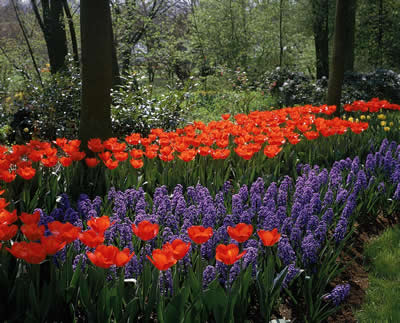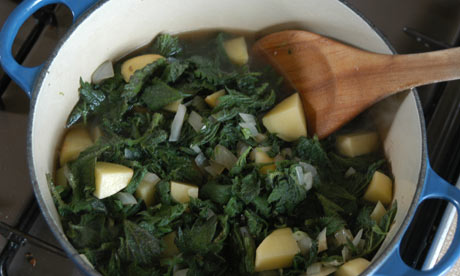Minnesotans can always talk about the weather - and with good reason. We didn't have a single flake of snow in March, April acted like May, and May started out acting like April but is closing out the month by acting like July!
Gardening is certainly my favorite activity when the weather turns warm. There's nothing like working with the soil and plants under a bright blue sky. Check out how your connection with the soil can improve your health.
Along with gardening come the weeds. Weeds aren't merely pests that should be pulled out with disdain or worse yet - sprayed with pesticides. Many of the plants that we consider weeds are highly nutritious plants. Eat Your Weedies will introduce you to the basics of "wild edibles."
Nettle is the first in a five-part series highlighting a different wild edible. Nettle also stars in the Recipe of the Month.
Look for features on chickweed, lambsquarter, wood sorrel and violets in future editions of Eat Your Weedies.
|
Gardening. . .Connections to the Soil
|
 Believe it or not, gardening can improve your digestion! In Chinese medicine the organ to which we attribute digestive function is the Spleen (energetically speaking that is). Each of the five main organs are represented by one of the five elements. The Spleen is represented by the Earth, so working with the soil can improve your Spleen's energetics. Believe it or not, gardening can improve your digestion! In Chinese medicine the organ to which we attribute digestive function is the Spleen (energetically speaking that is). Each of the five main organs are represented by one of the five elements. The Spleen is represented by the Earth, so working with the soil can improve your Spleen's energetics.
The Spleen also enjoys aromatics scents, and our gardens are filled with many such pleasures, especially plants belonging to the mint family. Breathe deeply as you inhale the lovely fragrance of peppermint or Bee Balm (aka Sweet Leaf or Wild Oregano).
Now, soil is not just dirt. Far from it. Soil is quite fascinating. Healthy soil displays a dynamic interplay of millions of organisms to ensure that the plants get all of the nutrients that they need to grow and flourish. Dan's and my current favorite gardening magazine is Acres USA - A Voice For Eco-Agriculture. Acres USA focuses on the soil and all that the soil supports, i.e. gardens, farms, animals and people.
If you'd like to know more about the soil, check out this article on Soil - Our Financial Institution.
|
Eat Your Weedies
|
Violets  | Today my lunch salad included spinach and arugula from our vegetable garden as well as a few wild edibles from my flower garden such as lambsquarter, wood sorrel, chickweed and violets.
Wild edibles contain far more nutrients than their cultivated cousins because they are not tended to with watering, composting, etc. They have to fend for themselves which means they produce more anti-oxidants, and they garner more nutrients from the soil. Ralph Waldo Emerson nicely sums up wild edibles' potential: "What is a weed? A plant whose virtues have not yet been discovered."
I was introduced to eating wild edibles while studying Western herbalism with Lise Wolff in 2008. I had a full spring and summer of eating wild edibles last year, and I have to admit I felt a bit of withdrawal from their dense green nutrients after the weather turned cold. It's nice to look forward to their abundance in the spring.
A few things to keep in mind when eating/serving
wild edibles: - Start with small amounts of wild edibles.
- Use your kitchen shears to snip
the wild edibles into small pieces when adding to a salad. They are
much more intensely flavored than their cultivated counterparts.
- Do not harvest wild edibles if chemicals have been
sprayed on them. - Always be 100% positive of your plant ID
- when in doubt - do without.

 Sam does a fabulous job of instructing one on how to correctly identify a wild edible as well as illustrating the difference between a wild edible and a not-so-edible look-a-like. He includes harvesting times, harvesting tips and recipes to boot. Rose Barlow's Prodigal Gardens - Medicinal Herbs and Wild Foods website is another resource I use quite frequently for the preparation and storage of our wild edibles. She offers many great articles and recipes on wild foods.
I just read an interesting blog by a CSA farmer and her relationship to weeds, Getting Intimate With My Weeds. Be sure to read to the end of the article (it's a bit long) because she also discusses invasive plants and compares human behavior to invasive plants.
|
Nettle. . .Wild Edible of the Month
| (Urtica dioica)
Photo by Tara Dennis  | Nettle, also known as stinging nettle, is truly a mineral and protein powerhouse among wild edibles. Its power is represented by its sting. The sting disappears when it is cooked or dried, but one must wear gloves (long sleeves are handy too) to harvest it and prep it for cooking, but don't let that deter you from cooking it up into a tasty dish.
Nettle contains approximately 10% protein - one of the highest percentages in a leafy green plant. It also contains calcium, Vitamin K, magnesium, potassium, iron, silica, sodium, sulphur, chlorophyll, Vitamin C, betacarotene, Vitamin B complex and easily absorbed amino acids (the building blocks of protein). What more could you ask for?
Photo by Steve Brill  | Harvest the top two leaf pairs on the nettle plant. Nettle leaves get tougher as they age, so it's best to harvest the new growth. Nettle is at its most tender early in the spring when it is only a couple of inches tall.
If you come across a big patch of nettles, and they are more than you could possible eat, you can dry to use in teas and brews. Cut them off at ground level, gather into bunches, tie with a string and hand upside down in a dark and dry room until completely dried. Store them in a 1/2 gallon glass jar. Keep the plant as whole as possible during storage and then crumble it up when you need it for teas or brews.
Add a teaspoon of crumbled dried nettle to your peppermint tea to help ease a headache or stuffy head. A brew differs from a tea by the length of its steeping time. Herbal teas are typically brewed for 5-10 minutes whereas a brew steeps for 5-8 hours. The long steeping time draws out the minerals contained in the plant. I drink a quart of nettle brew once or twice a week for a good dose of green minerals. To brew one quart of nettle tea: place 1/4 cup of dried nettle in a quart jar. Pour one quart of boiling water over the dried nettle, cover (preferable with a metal lid) and let steep overnight. Strain and enjoy throughout the day.
|
Recipe of the Month
| Nettle Soup
 I enjoy many of the wild edibles raw, but this is not the case for nettles. It is best cooked, and Nettle Soup is an easy recipe for a big springtime boost of nutrients. I enjoy many of the wild edibles raw, but this is not the case for nettles. It is best cooked, and Nettle Soup is an easy recipe for a big springtime boost of nutrients.
Nettle may be a bit harder to find in your yard or garden than many other wild edibles. I planted some on our boulevard before I discovered it growing in our alley. On occasion nettle will show up for sale at a farmer's market.
Click here for more tasty nettle recipes by Rose Barlow.
|
Timely Reminder
| Flex Medical Spending Accounts
 Time is flying by. . .we're already at the end of the fifth month of the year! I know last year a fair number of people had a good chunk of their flex medical funds left unspent by the end of the year, and they lost their funds! Definitely don't want that to happen again, so plan ahead. Acupuncture during the summer is great to rid one of rashes; alleviate muscle pain from over-exertion or gardening; can support your muscles, tendons and ligaments during training for sports events; relieve stress and tension; and much more. Time is flying by. . .we're already at the end of the fifth month of the year! I know last year a fair number of people had a good chunk of their flex medical funds left unspent by the end of the year, and they lost their funds! Definitely don't want that to happen again, so plan ahead. Acupuncture during the summer is great to rid one of rashes; alleviate muscle pain from over-exertion or gardening; can support your muscles, tendons and ligaments during training for sports events; relieve stress and tension; and much more.
|
|
|
 Enjoy the exploration of the wild side of your garden. As chef Jacques Pepin says at the end of his cooking show, "Happy Eating!" Enjoy the exploration of the wild side of your garden. As chef Jacques Pepin says at the end of his cooking show, "Happy Eating!"
Sincerely yours,
Katherine Krumwiede, L.Ac.
Diamond Stone Oriental Medicine, Inc.
612 872 9133
|
|
|
Quote of
the Month
|
|
Health is a matter
of choice, not a mystery of chance.
Aristotle
|
|
Newsletter Archive
|
There's a wealth of health-inducing information contained in past issues of my newsletter.
Newsletter Archive
|
|
Gift Certificates Are Available
|
Give the gift of good health to your friends and family.
|
The Benefits
of Acupuncture
|
De-stress
Alleviate pain
Improve concentration levels
Lift the cloud
of depression
Get a better night's sleep
Improve digestion
Boost energy levels
Insure success with smoking cessation
Excellent preventative medicine
And many more. . .
|
|
|